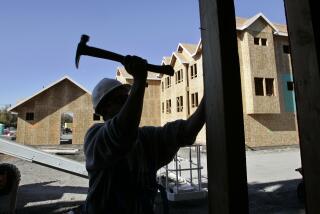Dishwasher Air Fitting Prevents Sewer Backup
- Share via
QUESTION: My inspection report cites a “missing dishwasher air gap fitting.” However, the dishwasher operates normally. Is this air gap really necessary?
ANSWER: The purpose of the air gap fitting is to prevent possible sewage backup into the dishwasher in the event of a sewer blockage.
These devices have been required for many years--so many that any working dishwasher almost certainly was installed after air gaps became a requirement. Other forms of air gap fittings are required at lawn sprinklers and hose bibs. They are important for health reasons.
Faulty Seal Causes Fogging of Windows
Q: Some of my double-glazed “thermopane” windows are fogged up and can’t be cleaned. What is the cause and the fix?
A: Fogged thermopane windows are caused by a faulty seal at the edge of the glass, allowing moisture to enter between the panes and condense. The only solution is to replace the faulty panes. If the windows are recent, you should check into possible warranty coverage, provided by most window manufacturers.
Lab Tests Determine If Asbestos Present
Q: I’ve heard that the “popcorn” or “cottage cheese” ceilings are asbestos. Is that true, and what should I do about it?
A: Sprayed “acoustic” ceilings such as you describe may or may not contain asbestos, but you are safest to assume it does.
To determine if asbestos is present requires laboratory tests, which are fortunately fairly simple and inexpensive. Check the Yellow Pages under “Test labs” for sources.
There is no requirement that this material be removed, but if work is to be done (such as remodeling or scraping the ceilings for the new smooth texture), you must first test.
If asbestos is present you must take precautions to prevent the house from becoming contaminated. In particular, removal of asbestos material must be done by a licensed asbestos abatement contractor (read big bucks) to assure that the house and occupants are protected.
Trees Near House Can Pose Roof Problems
Q: My house has several large trees that project over the roof. Is there any special maintenance required for this?
A: There are several concerns. Damage to the roof, either because of limbs that drag on the roof or debris that falls from the tree, is one. This requires periodic pruning of offending branches, and clearing of debris.
If the large trees are that close to the house, there is also a potential concern of root damage to the foundation or other paving. Sometimes, root pruning answers this concern.
Also, any large tree may seek out the moisture from seeping sewer lines and grow into the sewer, resulting in blockage and potential damage. For all these reasons, we suggest consulting a tree specialist wherever large trees grow but especially those that are near the house or in the path of the sewer line.
Cleaning Fireplace May Prevent Damage
Q: I have heard of having fireplaces cleaned, but have never had mine cleaned. Should I?
A: Having your chimney flue cleaned periodically is good insurance against chimney fires. The deposits in a flue from wood fires are combustible, and if allowed to accumulate can ignite and burn in an uncontrolled manner. How often a chimney requires cleaning depends upon your usage of the fireplace--frequency and type of wood burned.
Free Insulation From Recessed Lighting
Q: I have recessed light fixtures in my living room ceiling. Hearing that they shouldn’t be covered with insulation, I looked in the attic and couldn’t find the light fixtures--apparently they are buried under insulation. Should I panic?
A: The recessed ceiling fixtures should have visible air space around them in the attic, otherwise the fixture may overheat.
Fortunately, the solution is fairly simple. If the insulation is batts, simply cut them back several inches from the recessed light fixture. If the insulation is loose fill, you’ll need some type of rigid “dam,” such as you can make by cutting the bottom from a cardboard carton to block the insulation away from the fixture.
State Allows Plastic Pipe Only Outside
Q: I just bought a house that has a remodeled kitchen. There are white plastic pipes under the house below the kitchen. Is this OK?
A: Plastic water pipes are allowed in California only outdoors. Within (and under) the house use of plastic is not to California standards. We’ve stressed California because the requirements vary by geographical location. Some areas allow plastic water piping within the house.
Ross is the public relations chairman for the California Real Estate Inspection Assn. (CREIA / ASHI), a statewide trade association of home inspectors. Readers may send their comments or questions on home inspection topics to Bill Ross, CREIA, 1100 N St., Suite 5-D, Sacramento, Calif. 95814.
More to Read
Sign up for Essential California
The most important California stories and recommendations in your inbox every morning.
You may occasionally receive promotional content from the Los Angeles Times.






